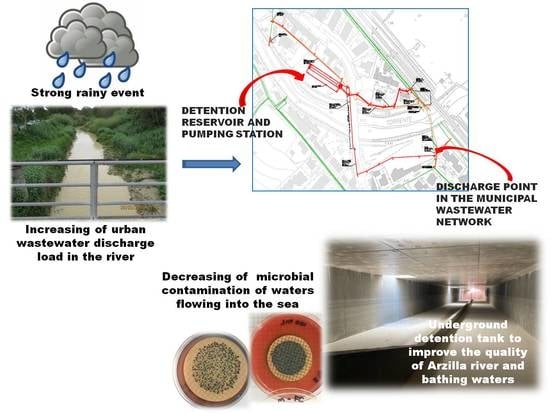A Detention Reservoir Reduced Combined Sewer Overflows and Bathing Water Contamination Due to Intense Rainfall
Abstract
:1. Introduction
2. Materials and Methods
2.1. Study Area
2.2. Existing System and Project Description
2.3. Feasibility Study and Design Criteria
2.4. Microbiological Analyses
3. Results and Discussion
3.1. Tank System and Operation
3.2. Microbial Load Control after the Tank
Author Contributions
Funding
Institutional Review Board Statement
Informed Consent Statement
Data Availability Statement
Acknowledgments
Conflicts of Interest
References
- Marini, M.; Fornasiero, P.; Artegiani, A. Variations of hydrochemical features in the coastal waters of Monte Conero: 1982–1990. Mar. Ecol. 2002, 23, 258–271. [Google Scholar] [CrossRef]
- Morabito, G.; Mazzocchi, M.G.; Salmaso, N.; Zingone, A.; Bergami, C.; Flaim, G.; Accoroni, S.; Basset, A.; Bastianini, M.; Belmonte, G.; et al. Plankton dynamics across the freshwater, transitional and marine research sites of the LTER-Italy Network. Patterns, fluctuations, drivers. Sci. Total Environ. 2018, 627, 373–387. [Google Scholar] [CrossRef] [PubMed]
- Pall, P.; Aina, T.; Stone, D.A.; Stott, P.A.; Nozawa, T.; Hilberts, A.G.J.; Lohmann, D.; Allen, M.R. Anthropogenic greenhouse gas contribution to flood risk in England and Wales in autumn 2000. Nature 2011, 470, 382–385. [Google Scholar] [CrossRef] [PubMed]
- Trenberth, K.; Meehl, J.; Masters, J.; Somerville, R. Current Extreme Weather and Climate Change; Climate Comunication Report; 2011; Available online: https://www.climatecommunication.org/wp-content/uploads/2011/09/Extreme-Weather-and-Climate-Change.pdf (accessed on 30 November 2021).
- Grilli, F.; Accoroni, S.; Acri, F.; Aubry, F.B.; Bergami, C.; Cabrini, M.; Campanelli, A.; Giani, M.; Guicciardi, S.; Marini, M.; et al. Seasonal and Interannual Trends of Oceanographic Parameters over 40 Years in the Northern Adriatic Sea in Relation to Nutrient Loadings Using the EMODnet Chemistry Data Portal. Water 2020, 12, 2280. [Google Scholar] [CrossRef]
- Libertino, A.; Ganora, D.; Claps, P. Evidence for Increasing Rainfall Extremes Remains Elusive at Large Spatial Scales: The Case of Italy. Geophys. Res. Lett. 2019, 46, 7437–7446. [Google Scholar] [CrossRef]
- Al Aukidy, M.; Verlicchi, P. Contributions of combined sewer overflows and treated effluents to the bacterial load released into a coastal area. Sci. Total Environ. 2017, 607–608, 483–496. [Google Scholar] [CrossRef] [PubMed]
- Penna, P.; Baldrighi, E.; Betti, M.; Bolognini, L.; Campanelli, A.; Capellacci, S.; Casabianca, S.; Ferrarin, C.; Giuliani, G.; Grilli, F.; et al. Water quality integrated system: A strategic approach to improve bathing water management. J. Environ. Manag. 2021, 295, 113099. [Google Scholar] [CrossRef] [PubMed]
- Amorim, E.; Ramos, S.; Bordalo, A.A. Relevance of temporal and spatial variability for monitoring the microbiological water quality in an urban bathing area. Ocean Coast. Manag. 2014, 91, 41–49. [Google Scholar] [CrossRef]
- WHO Coastal and Fresh Waters. Guidelines for Safe Recreational Water Environments; World Health Organization: Geneva, Switzerland, 2003; Volume 1, pp. 1–219. ISBN 9241545801. [Google Scholar]
- Wade, T.J.; Pai, N.; Eisenberg, J.N.S.; Colford, J.M. Do US Environmental Protection Agency water quality guidelines for recreational waters prevent gastrointestinal illness? A systematic review and meta-analysis. Environ. Health Perspect. 2003, 111, 1102–1109. [Google Scholar] [CrossRef] [PubMed]
- Andersen, S.T.; Erichsen, A.C.; Mark, O.; Albrechtsen, H.J. Effects of a 20 year rain event: A quantitative microbial risk assessment of a case of contaminated bathing water in Copenhagen, Denmark. J. Water Health 2013, 11, 636–646. [Google Scholar] [CrossRef] [PubMed] [Green Version]
- Council Directive no. 91/271/EEC. In Official Journal of the European Communities; European Union: Maastricht, The Netherlands, 1991; pp. 40–52.
- Palazón, A.; López, I.; Aragonés, L.; Villacampa, Y.; Navarro-González, F.J. Modelling of Escherichia coli concentrations in bathing water at microtidal coasts. Sci. Total Environ. 2017, 593–594, 173–181. [Google Scholar] [CrossRef] [PubMed] [Green Version]
- Regione Lombardia. Regione Lombardia-Bollettino Ufficiale Linea Guida Per la Progettazione e Realizzazione di Sistemi di Trattamento Delle Acque Reflue Provenienti da Scarichi di Sfioratori di Reti Fognarie. 2020. Available online: https://www.regione.lombardia.it (accessed on 30 November 2021).
- Bornatici, L.; Ciaponi, C.; Papiri, S. Control Of Urban Runoff Stormwater Discharge To Receiving Waters Using Off-Line Storage. In Enhancing Urban Environment by Environmental Upgrading and Restoration; Marsalek, J., Sztruhar, D., GiulianelliBen, M., Urbonas, B., Eds.; Kluwer Academic: Dordrecht, The Netherlands, 2004; pp. 33–44. [Google Scholar]
- Fonder, N.; Headley, T. Systematic Classification, Nomenclature and Reporting for Constructed Treatment Wetlands. In Water and Nutrient Management in Natural and Constructed Wetlands; Vymazal, J., Ed.; Springer: Berlin/Heidelberg, Germany, 2010; pp. 191–213. ISBN 9789048195848. [Google Scholar]
- Liscum, F.; Goss, R.L.; Paul, E.M. Effects on Water Quality Due to Flood-Water Detention by Barker and Addicks Reservoirs; Water-Resources Investigations Report 86-4356; U.S. Geological Survey: Austin, TX, USA, 1987. [Google Scholar]
- Myers, B.; Sagi, I.; Van Leeuwen, J.; Beecham, S. Water Quality Improvement by Base Course Aggregate in a Permeable Pavement with Underlying Reservoir Structure. In Rainwater and Urban Design 2007; Australia: Barton, Australia, 2007; pp. 838–844. ISBN 1877040614. [Google Scholar]
- Gutiérrez, E.; Malgrat, P.; Suñer, D.; Otheguy, P. Real Time Management of Bathing Water Quality in Barcelona. In Proceedings of the 7th International Conference on Sustainable Techniques and Strategies for Urban Water Management (NOVATECH 2007), Lyon, France, 16 July 2010; pp. 1–10. [Google Scholar]
- Souza, F.P.; Costa, M.E.L.; Koide, S. Hydrological modelling and evaluation of detention ponds to improve urban drainage system and water quality. Water 2019, 11, 1547. [Google Scholar] [CrossRef] [Green Version]
- Andrés-Doménech, I.; Segura, J.B.M. Multivariate rainfall distributions for stormwater detention tank sizing using probabilistic and single-event approaches. A comparison between northern and eastern Spain. In Proceedings of the 11th International Conference on Urban Drainage, Edinburgh, UK, 23 September 2008; pp. 1–10. [Google Scholar]
- Ferrarin, C.; Penna, P.; Penna, A.; Spada, V.; Ricci, F.; Bilić, J.; Krzelj, M.; Ordulj, M.; Šikoronja, M.; Ðuračić, I.; et al. Modelling the quality of bathing waters in the Adriatic sea. Water 2021, 13, 1525. [Google Scholar] [CrossRef]
- Ferrari, E.; Versace, P. La Valutazione delle Piene in Italia; Ferrari, E., Versace, P., Eds.; Consiglio Nazionale delle Ricerche: Roma, Italy, 1990. [Google Scholar]
- Rossi, F.; Fiorentino, M.; Versace, P. Two-Component Extreme Value Distribution for Flood Frequency Analysis. Water Resour. Res. 1984, 20, 847–856. [Google Scholar] [CrossRef]
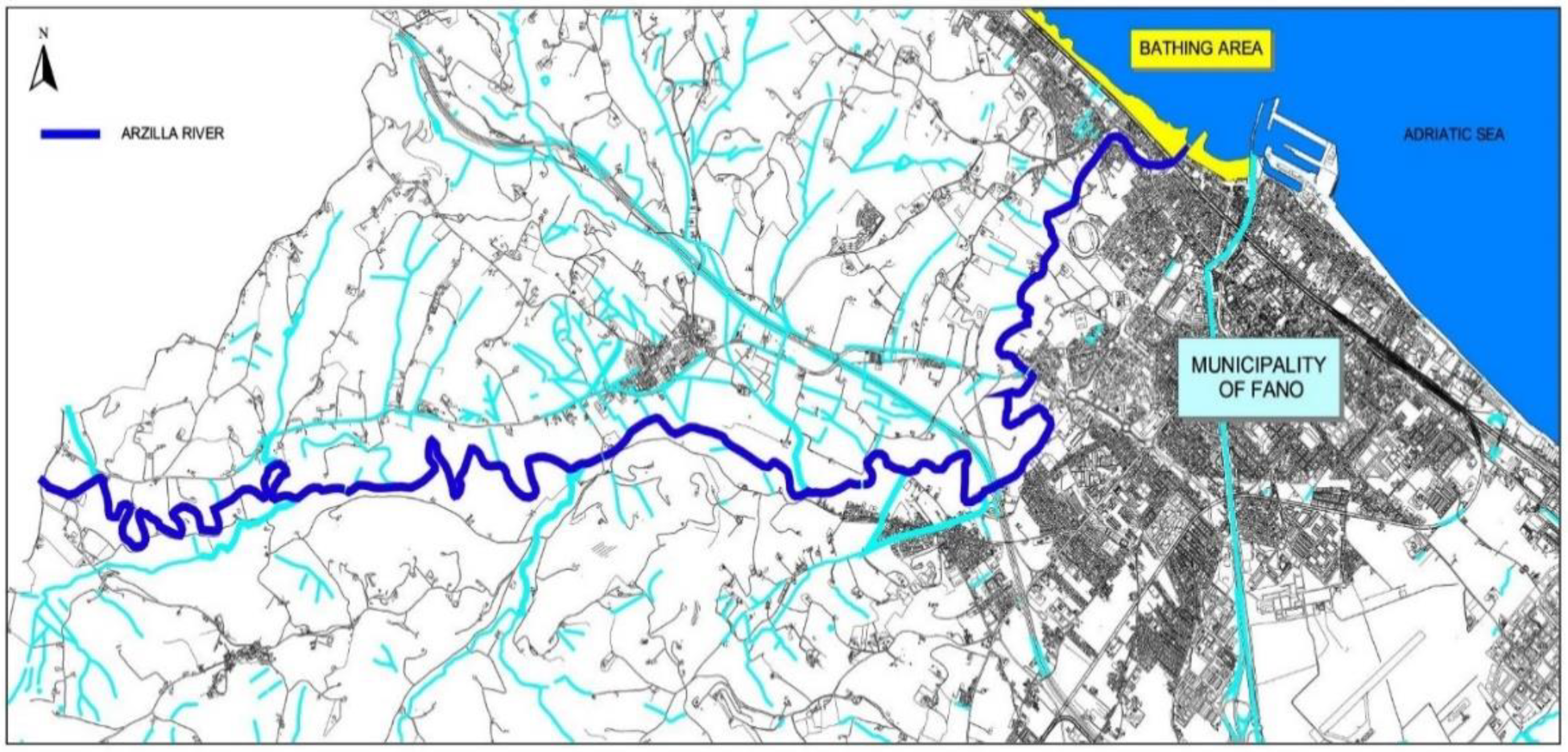

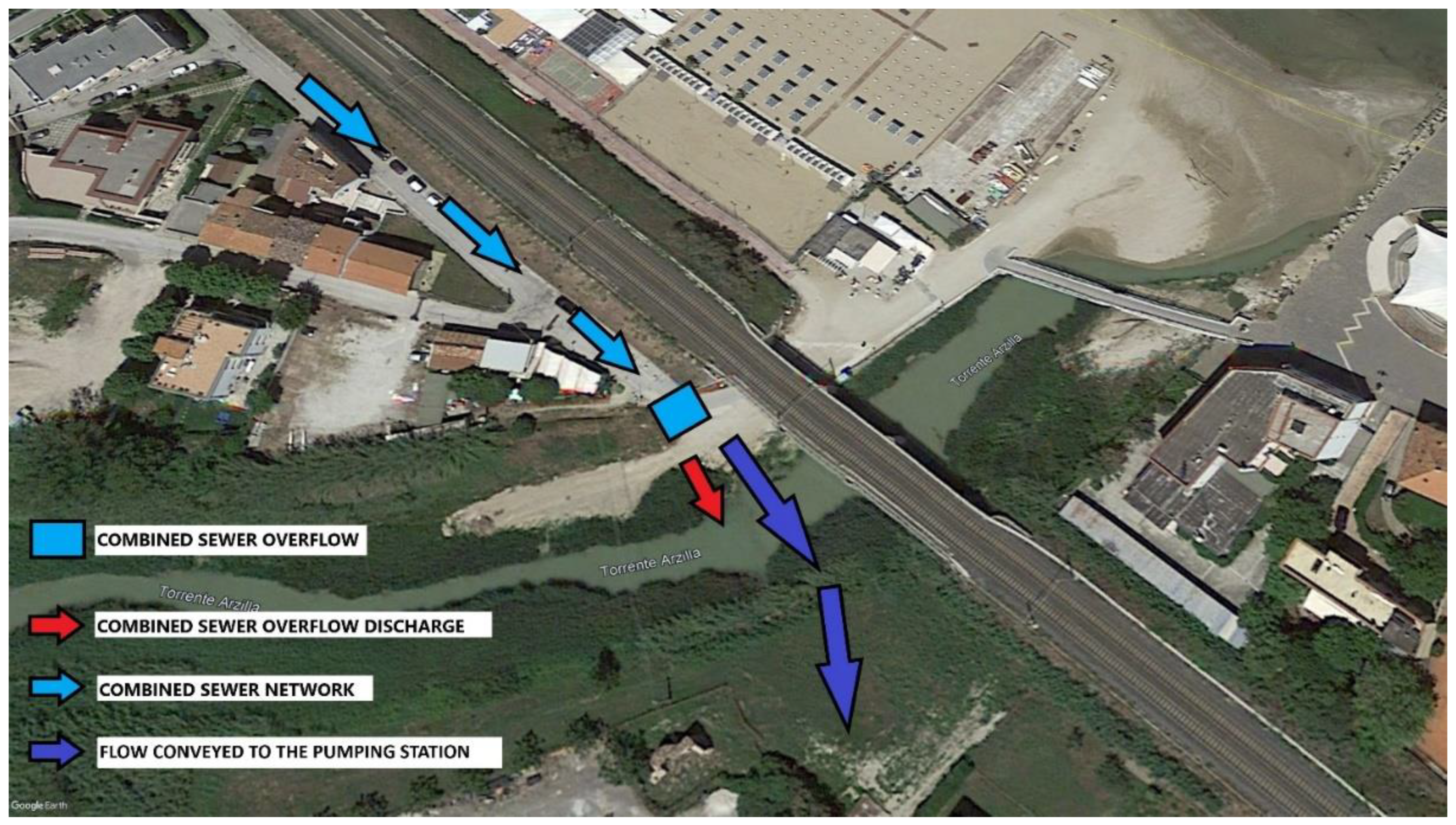
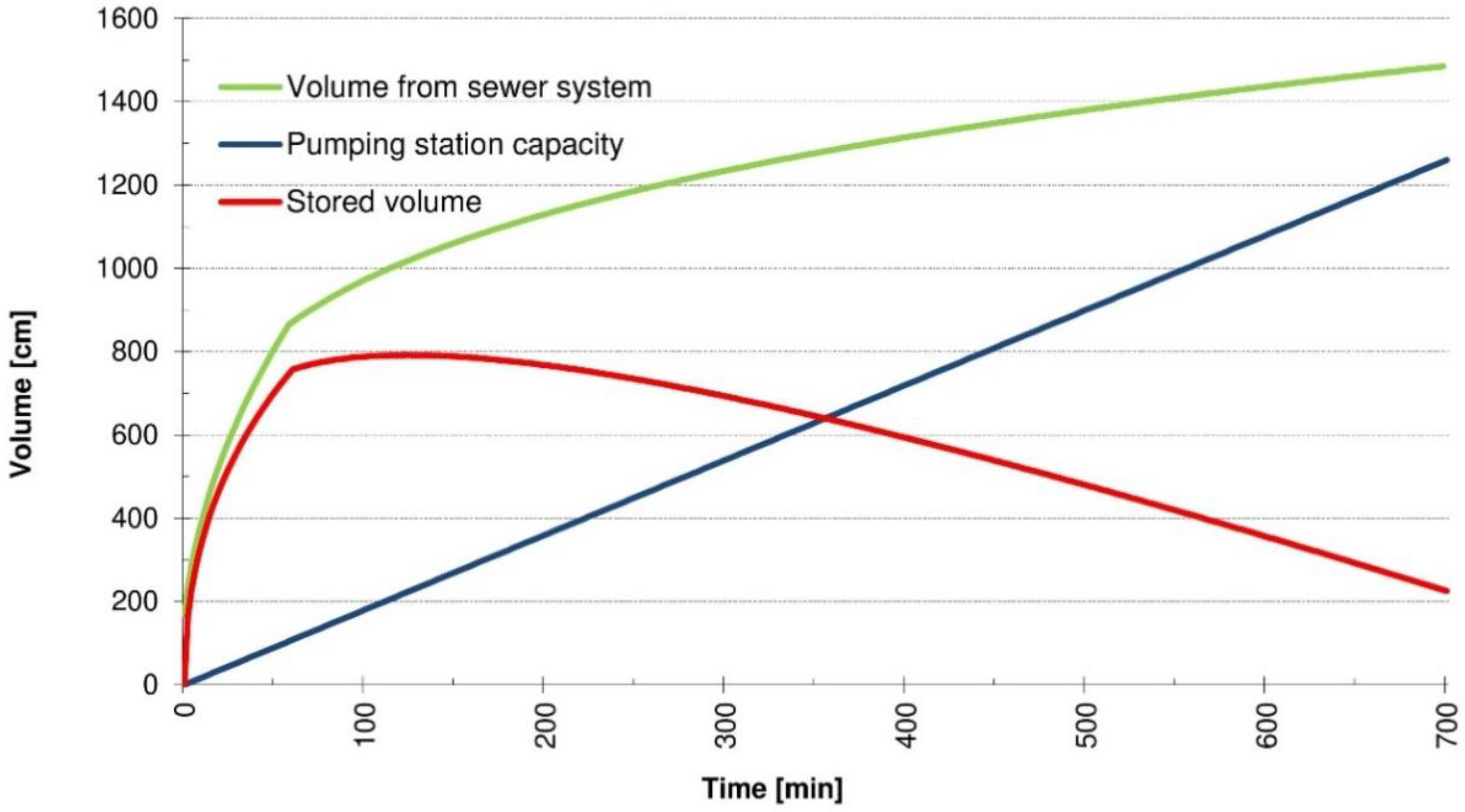
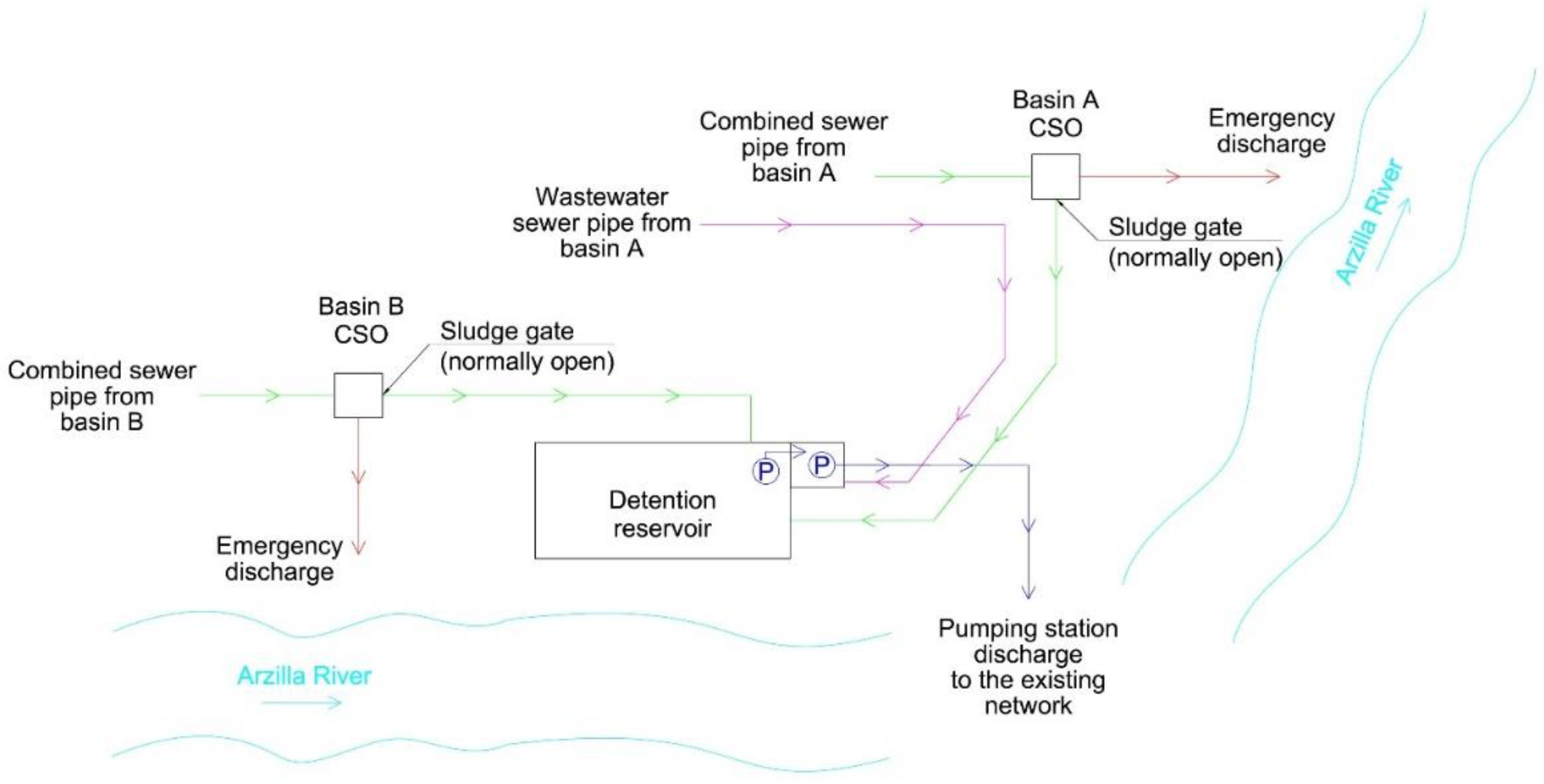

| Date | Rain Height | Rain Intensity, Max | Event Duration | Volume Stored in Tank |
|---|---|---|---|---|
| (mm) | (mm h−1) | (h-mm) | (m3) | |
| 13 July 2021 | 17 | 176 | 1 h 0 min | 556 |
| 16 July 2021 | 13 | 16 | 5 h 00 min | 513 |
| 23 August 2021 | 30 | 260 | 0 h 40 min | 740 |
| 25 August 2021 | 16 | 40 | 3 h 20 min | 438 |
| 28 August 2021 | 15 | 20 | 2 h 00 min | 607 |
| 26 September 2021 | 30 | 340 | 15 min | 807 |
Publisher’s Note: MDPI stays neutral with regard to jurisdictional claims in published maps and institutional affiliations. |
© 2021 by the authors. Licensee MDPI, Basel, Switzerland. This article is an open access article distributed under the terms and conditions of the Creative Commons Attribution (CC BY) license (https://creativecommons.org/licenses/by/4.0/).
Share and Cite
Romei, M.; Lucertini, M.; Esposito Renzoni, E.; Baldrighi, E.; Grilli, F.; Manini, E.; Marini, M.; Iagnemma, L. A Detention Reservoir Reduced Combined Sewer Overflows and Bathing Water Contamination Due to Intense Rainfall. Water 2021, 13, 3425. https://doi.org/10.3390/w13233425
Romei M, Lucertini M, Esposito Renzoni E, Baldrighi E, Grilli F, Manini E, Marini M, Iagnemma L. A Detention Reservoir Reduced Combined Sewer Overflows and Bathing Water Contamination Due to Intense Rainfall. Water. 2021; 13(23):3425. https://doi.org/10.3390/w13233425
Chicago/Turabian StyleRomei, Marco, Matteo Lucertini, Enrico Esposito Renzoni, Elisa Baldrighi, Federica Grilli, Elena Manini, Mauro Marini, and Luca Iagnemma. 2021. "A Detention Reservoir Reduced Combined Sewer Overflows and Bathing Water Contamination Due to Intense Rainfall" Water 13, no. 23: 3425. https://doi.org/10.3390/w13233425
APA StyleRomei, M., Lucertini, M., Esposito Renzoni, E., Baldrighi, E., Grilli, F., Manini, E., Marini, M., & Iagnemma, L. (2021). A Detention Reservoir Reduced Combined Sewer Overflows and Bathing Water Contamination Due to Intense Rainfall. Water, 13(23), 3425. https://doi.org/10.3390/w13233425







